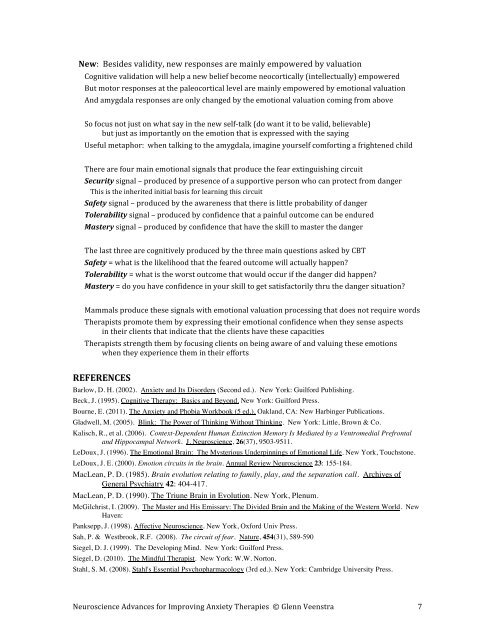Veenstra 170 - Anxiety Disorders Association of America
Veenstra 170 - Anxiety Disorders Association of America
Veenstra 170 - Anxiety Disorders Association of America
Create successful ePaper yourself
Turn your PDF publications into a flip-book with our unique Google optimized e-Paper software.
New: Besides validity, new responses are mainly empowered by valuation<br />
Cognitive validation will help a new belief become neocortically (intellectually) empowered<br />
But motor responses at the paleocortical level are mainly empowered by emotional valuation<br />
And amygdala responses are only changed by the emotional valuation coming from above<br />
So focus not just on what say in the new self-‐talk (do want it to be valid, believable)<br />
but just as importantly on the emotion that is expressed with the saying<br />
Useful metaphor: when talking to the amygdala, imagine yourself comforting a frightened child<br />
There are four main emotional signals that produce the fear extinguishing circuit<br />
Security signal – produced by presence <strong>of</strong> a supportive person who can protect from danger<br />
This is the inherited initial basis for learning this circuit<br />
Safety signal – produced by the awareness that there is little probability <strong>of</strong> danger<br />
Tolerability signal – produced by confidence that a painful outcome can be endured<br />
Mastery signal – produced by confidence that have the skill to master the danger<br />
The last three are cognitively produced by the three main questions asked by CBT<br />
Safety = what is the likelihood that the feared outcome will actually happen?<br />
Tolerability = what is the worst outcome that would occur if the danger did happen?<br />
Mastery = do you have confidence in your skill to get satisfactorily thru the danger situation?<br />
Mammals produce these signals with emotional valuation processing that does not require words<br />
Therapists promote them by expressing their emotional confidence when they sense aspects<br />
in their clients that indicate that the clients have these capacities<br />
Therapists strength them by focusing clients on being aware <strong>of</strong> and valuing these emotions<br />
when they experience them in their efforts<br />
REFERENCES<br />
Barlow, D. H. (2002). <strong>Anxiety</strong> and Its <strong>Disorders</strong> (Second ed.). New York: Guilford Publishing.<br />
Beck, J. (1995). Cognitive Therapy: Basics and Beyond. New York: Guilford Press.<br />
Bourne, E. (2011). The <strong>Anxiety</strong> and Phobia Workbook (5 ed.). Oakland, CA: New Harbinger Publications.<br />
Gladwell, M. (2005). Blink: The Power <strong>of</strong> Thinking Without Thinking. New York: Little, Brown & Co.<br />
Kalisch, R., et al. (2006). Context-Dependent Human Extinction Memory Is Mediated by a Ventromedial Prefrontal<br />
and Hippocampal Network. J. Neuroscience, 26(37), 9503-9511.<br />
LeDoux, J. (1996). The Emotional Brain: The Mysterious Underpinnings <strong>of</strong> Emotional Life. New York, Touchstone.<br />
LeDoux, J. E. (2000). Emotion circuits in the brain. Annual Review Neuroscience 23: 155-184.<br />
MacLean, P. D. (1985). Brain evolution relating to family, play, and the separation call. Archives <strong>of</strong><br />
General Psychiatry 42: 404-417.<br />
MacLean, P. D. (1990). The Triune Brain in Evolution. New York, Plenum.<br />
McGilchrist, I. (2009). The Master and His Emissary: The Divided Brain and the Making <strong>of</strong> the Western World. New<br />
Haven:<br />
Panksepp, J. (1998). Affective Neuroscience. New York, Oxford Univ Press.<br />
Sah, P. & Westbrook, R.F. (2008). The circuit <strong>of</strong> fear. Nature, 454(31), 589-590<br />
Siegel, D. J. (1999). The Developing Mind. New York: Guilford Press.<br />
Siegel, D. (2010). The Mindful Therapist. New York: W.W. Norton.<br />
Stahl, S. M. (2008). Stahl's Essential Psychopharmacology (3rd ed.). New York: Cambridge University Press.<br />
Neuroscience Advances for Improving <strong>Anxiety</strong> Therapies © Glenn <strong>Veenstra</strong> 7


